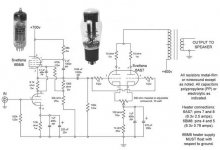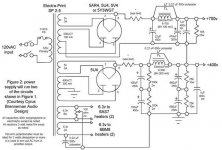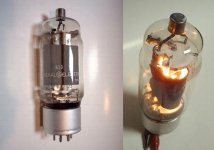Banned
Joined 2002
Banned
Joined 2002
The thread for the 'lilliput' amp is farely similar, same output triode anyways.
This circuit has more gain and will work better than the lilliput version. I think it will sound great.
I built something similar but used a single triode at the input. I tried ECC83, ECC81, ECC85, and E88CC. It didn't have enuff gain, tho much more than the lilliput amp. I also used an outputtranny that was meant for EL84s so it was a bad match there too. So I didn't get the power I could have, but it sounded very good up untill clipping. I built it with parts laying around the house at the same time as I built an OTL using the same pwr tube just to hear the tube in a SE tranny amp.
The 6AS7 needs a large drive voltage to give it's max. +-100V is about right. The lilliput amp isn't even close, unless it's driven by a very large signal that is.
The large drive requirement is the only downer regarding this tube, soundwise it's excellent.
This circuit has more gain and will work better than the lilliput version. I think it will sound great.
I built something similar but used a single triode at the input. I tried ECC83, ECC81, ECC85, and E88CC. It didn't have enuff gain, tho much more than the lilliput amp. I also used an outputtranny that was meant for EL84s so it was a bad match there too. So I didn't get the power I could have, but it sounded very good up untill clipping. I built it with parts laying around the house at the same time as I built an OTL using the same pwr tube just to hear the tube in a SE tranny amp.
The 6AS7 needs a large drive voltage to give it's max. +-100V is about right. The lilliput amp isn't even close, unless it's driven by a very large signal that is.
The large drive requirement is the only downer regarding this tube, soundwise it's excellent.
The 6AS7 needs a large drive voltage to give it's max. +-100V is about right.
Yeap ! Did you notice the 700V B+ on the driver ?
This design afraid me a lot
Yves.
Banned
Joined 2002
Banned
Joined 2002
i'm not scared of voltage. But then again i'm super careful and always aware of was is going on..
Sure, me too !
I was wondering about Vfk of this poor 6BM8

Both tubes seems quite stressed.
It's a very special design IMHO, perhaps vy good anyway !
Yves
Zero Cool said:Make sure you guys check out www.atma-sphere.com Ralph Karsten is the 6AS7 tube king!!!!
Bum link?

Hi,
Sorry but how can you tell?
Have you ever heard a Lilliput? I really doubt it.
The Lilliput's gain is set for high level sources, say approximately 2VRMS.
Modern line level sources and phonopreamps will not have any problem whatsoever.
A 700V B+ for a mu-follower to drive a simple 6AS7G, both halves of a DUAL, not TWIN, triode in //, that's really no garantee for good sound at all.
To my mind it's just a Svetlana showcase design and not their brightest either...Bah.
The Lilliput also uses the 6080 as a powertube and I can assure you that a driver signal of about 60V is more than ample to make the amp sing.
A high transconductance input/driver combined with a high current, low mu output tube isn't too bad an idea either...
I'm not out to defend one over the other but I'm pretty darn certain that the Lilliput as a kit or at least using the MegaHerz OPT under similar conditions will outperform the Svet design hands down given the right speaker, it's just that good.
Note that I'm not saying the Svet design is bad.
It's just needlessly complicated, uses a silly driver stage with a dangerously high B+ where there's absolutely no need to and if you really need that little bit more power I'd rather go for a single 6C33-C than put a dual triode in // which will have to be selected for matched halves to boot....
Now if anyone can find the iron for that one that will be on a par with the MegaHerz OPT's performance, let me know.
I'll build it straight away...Promise.
Cheers,
This circuit has more gain and will work better than the lilliput version. I think it will sound great.
Sorry but how can you tell?
Have you ever heard a Lilliput? I really doubt it.
The Lilliput's gain is set for high level sources, say approximately 2VRMS.
Modern line level sources and phonopreamps will not have any problem whatsoever.
A 700V B+ for a mu-follower to drive a simple 6AS7G, both halves of a DUAL, not TWIN, triode in //, that's really no garantee for good sound at all.
To my mind it's just a Svetlana showcase design and not their brightest either...Bah.
The Lilliput also uses the 6080 as a powertube and I can assure you that a driver signal of about 60V is more than ample to make the amp sing.
A high transconductance input/driver combined with a high current, low mu output tube isn't too bad an idea either...
I'm not out to defend one over the other but I'm pretty darn certain that the Lilliput as a kit or at least using the MegaHerz OPT under similar conditions will outperform the Svet design hands down given the right speaker, it's just that good.
Note that I'm not saying the Svet design is bad.
It's just needlessly complicated, uses a silly driver stage with a dangerously high B+ where there's absolutely no need to and if you really need that little bit more power I'd rather go for a single 6C33-C than put a dual triode in // which will have to be selected for matched halves to boot....
Now if anyone can find the iron for that one that will be on a par with the MegaHerz OPT's performance, let me know.
I'll build it straight away...Promise.
Cheers,
Banned
Joined 2002
I agree the llilliput amp might be better at very low levels, but the svet design get more out of the output tube.
I think idling a 6AS7 at 50mA in a SE design is too low, better to at least idle at 75mA. It can idle happily at over 100mA all day long and u'd get more available power. Granted, that limits the anode voltage and thus requires a tranny with a very low ratio and that may be hard to find. In a design that give u such low power it's good to get the most that u can isn't it?
What ratio does the MHz tranny have?
I dont think the svet design is just thrown in their app.notes just for ***** and giggles. It is designed out of house and I think it is very good. I dont think I'll build it myself because I favor all-triode designs. However...the more instrument amps I build the more respect I am starting to have for pentodes..they can sound good too.
I also dont believe paralleling these triodes will have an audible negative effect. They parallel very well actually, this I know since I have several OTLs with just those power tubes.
I think idling a 6AS7 at 50mA in a SE design is too low, better to at least idle at 75mA. It can idle happily at over 100mA all day long and u'd get more available power. Granted, that limits the anode voltage and thus requires a tranny with a very low ratio and that may be hard to find. In a design that give u such low power it's good to get the most that u can isn't it?
What ratio does the MHz tranny have?
I dont think the svet design is just thrown in their app.notes just for ***** and giggles. It is designed out of house and I think it is very good. I dont think I'll build it myself because I favor all-triode designs. However...the more instrument amps I build the more respect I am starting to have for pentodes..they can sound good too.
I also dont believe paralleling these triodes will have an audible negative effect. They parallel very well actually, this I know since I have several OTLs with just those power tubes.
Hi,
No.
What I'm saying is that if you want the same quality OPT as the Lilliput design you'll be hard pressed to find it.
If you want to settle for less then that's fine by me but as far as I'm concerned it's the iron that's the masterpiece and that's 90% of what sets these designs apart.
Gainwise and powerwise? No, I don't think so. Qualitywise, yes.
That's what the Svet design is, actually.
But it invariably does.
Quite to the contrary, they don't parallel well at all.
I too have built and use OTL amps and there's just no way to keep these tubes from current hogging.
Even if you can select from a few hundred of them, they only stay in line for a few hours if you're lucky.
Cheers,
fdegrove are you saying that it is going to be really expensive or hard to get iron for my Tube amps ?
No.
What I'm saying is that if you want the same quality OPT as the Lilliput design you'll be hard pressed to find it.
If you want to settle for less then that's fine by me but as far as I'm concerned it's the iron that's the masterpiece and that's 90% of what sets these designs apart.
In a design that give u such low power it's good to get the most that u can isn't it?
Gainwise and powerwise? No, I don't think so. Qualitywise, yes.
I dont think I'll build it myself because I favor all-triode designs.
That's what the Svet design is, actually.
I also dont believe paralleling these triodes will have an audible negative effect.
But it invariably does.
They parallel very well actually, this I know since I have several OTLs with just those power tubes.
Quite to the contrary, they don't parallel well at all.
I too have built and use OTL amps and there's just no way to keep these tubes from current hogging.
Even if you can select from a few hundred of them, they only stay in line for a few hours if you're lucky.
Cheers,
Frank, the basic problem comes from the 6080's best virtue- the high transconductance. Tiny drifts in required grid-cathode voltage cause profound effects in plate current. It can be overcome with some fancy autobias circuitry, but in a conventional paralleled situation, it's just as you say.
Geek said:
Bum link?
Yes i just got horrible news yesterday that Ralph took his web page down due to some "partner" issues!!!
You might be able to do a yahoo seach and find it in cache.
Zero

Hi,
I built a SE amp based on Russian 6H13C dual triode (similar to 6AS7), but was dissapointed. The tube is designed for power regulator (the same with 6C19C, 6C41C and 6C33C). Those sounded better to me if used in OTL config (e.g. cathode follower).
If you want to make a headphone amp - 6H13C and 6C19C are splendid (tested with Sehnheiser HD600 and good CD source).
Using parallel feed (plate choke + cap + xformer), which I did not try at the time, could be a solution for the tube.
Nevertheless, try it, maybe I missed something which you won't
I built a SE amp based on Russian 6H13C dual triode (similar to 6AS7), but was dissapointed. The tube is designed for power regulator (the same with 6C19C, 6C41C and 6C33C). Those sounded better to me if used in OTL config (e.g. cathode follower).
If you want to make a headphone amp - 6H13C and 6C19C are splendid (tested with Sehnheiser HD600 and good CD source).
Using parallel feed (plate choke + cap + xformer), which I did not try at the time, could be a solution for the tube.
Nevertheless, try it, maybe I missed something which you won't
I'm trying to use 6080 too.
Dunnow how to post picture, so i try a brief explain: use both section paralleled on a 1kohm tranformer, QP is 80mA@150Va, Vg=-60V each section; drive it with ecc88, one triode as a common cathode, (gives gain), direct coupled to a cathode follower (sections are NOT from the same valve, altought i think its possible) , but connected in a strange manner suggested me by a friend (he said it's a "Brosky's idea", but i don'know him).
GainStage and PowerStage have different PSU, so i can arrange a DC connection between drive and power stage. This way, amplifier is totally DC, and there's no resistor on the 6080 cathode.
Simulations show a THD around 6%@5.5W, and i think this value is approximatively right also for the posted schematic (@2.8W for one section)...
I'm working on the PSU's, but few days ago i think about apply cathode feedback with an apposite winding of the output trans (i build it by myself).
So my questions are:
1-what about CFb for the Se6080?
2-does anyone can explain me mathematically how CFb works in HD reduction? I can only calculate effects on the drive voltage required...

I'm a damned newbie...

- Status
- This old topic is closed. If you want to reopen this topic, contact a moderator using the "Report Post" button.
- Home
- Amplifiers
- Tubes / Valves
- 6AS7 Mono Block's


